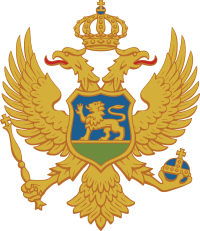Islam in Montenegro
| Total population | |
|---|---|
| 118,477 (2011) | |
| Regions with significant populations | |
| Largest concentrations in the northeastern municipalities Bijelo Polje, Berane, Rožaje and Plav and southeastern municipalities Ulcinj, Bar and Tuzi. | |
| Religions | |
| Islam, Sunni | |
| Languages | |
| Montenegrin, Bosnian, Albanian and Roma |
| Part of a series on |
| Montenegrins |
|---|
 |
| By region or country |
| Recognized populations |
|
Montenegro Serbia Bosnia and Herzegovina Croatia Republic of Macedonia Kosovo Albania |
| Diaspora |
|
Europe · Austria · Denmark France · Germany Italy · Luxembourg Russia · Slovenia Sweden · Switzerland United Kingdom |
|
North America United States · Canada · Mexico |
|
South America Argentina · Chile Bolivia · Brazil · Colombia |
|
Oceania Australia · New Zealand |
| Culture |
|
Literature · Music · Art · Cinema Cuisine · Dress · Sport |
| Religion |
| Language and dialects |
| Montenegrin · Serbian |
| History |
|
History of Montenegro Rulers |
Muslims in Montenegro form the largest minority religion in the country. According to the 2011 census, Montenegro's 118,477 Muslims make up 20% of the total population.[1] Montenegro's Muslims belong to the Sunni branch.
History
In the 15th century the Montenegrin king Ivan (1465–1490) was at war with the infiltrating Venetians unable to maintain war on both fronts Ottoman Empire had conquered much of Montenegro's territory and introduced Islam. Ivan's third son Staniša Crnojević was the first prominent Montenegrin of the Muslim faith, and since then Islam was not an uncommon religion to the Crnojević Montenegrin ruling dynasty.
Staniša Crnojević took up the name Skenderbeg Crnojević and ruled from his capital at Cetinje. He is well known as one of the most prominent Muslim administrators in the northern reaches of the Ottoman Empire of Slavic origins during the reign of Sultan Selim I. Staniša Crnojević is known to have commanded an army of approximately 3000 Akıncı he also maintained correspondence with neighboring contemporaries such as Gazi Husrev-beg.
Twenty-first century
The Muslims of Montenegro are mostly Bosniaks and Albanians by ethnicity but also some are declared Muslims by nationality and Montenegrins. The Muslims can be mostly found in the Sandžak region in Montenegro and Ulcinj, Bar and Podgorica. Bosniaks have virtually the same ethnic background with the Montenegrin Muslims, but differ in ideology of what ethnicity they belong to. In Montenegro are established 13 Councils of Islamic Community: Podgorica, Tuzi, Dinoša, Bar, Ostros, Ulcinj, Pljevlja, Bijelo Polje, Berane, Petnjica, Rožaje, Plav and Gusinje.
Demographics
Ethnic composition according to the 2011 census: Of the total 118,477 Muslims:
- 53,453 Bosniaks
- 22,267 Albanians
- 20,270 Slavic Muslims
- 12,758 Montenegrins
- 5,034 Roma
- 2,003 Egyptians
- 428 Montenigrin Muslims
- 1,435 other or does not want to declare
- 364 Bosniaks/Muslims
- 169 Bosnians
- 195 Gorani
- 101 Turks
Gallery
- Sultan Murat II mosque in Rožaje.
- Pljevlja Mosque
- Demographics of the Montenegrin Muslim population.
See also
References
- ↑ "Census of Population, Households and Dwellings in Montenegro 2011" (PDF). Monstat. pp. 14, 15. Retrieved October 16, 2016. For the purpose of the chart, the categories 'Islam' and 'Muslims' were merged.
External links
- http://www.monteislam.com/
- http://www.seher-tuzi.org/
- http://www.almanah.co.me/
- http://www.savjetmuslimanacg.com
